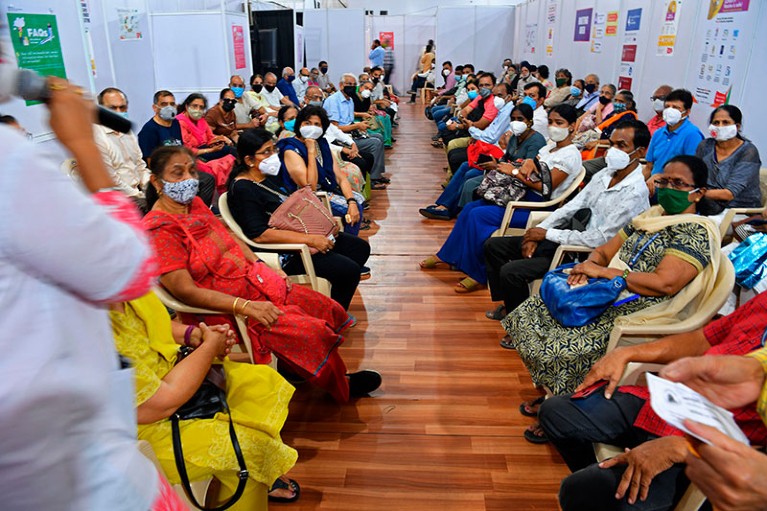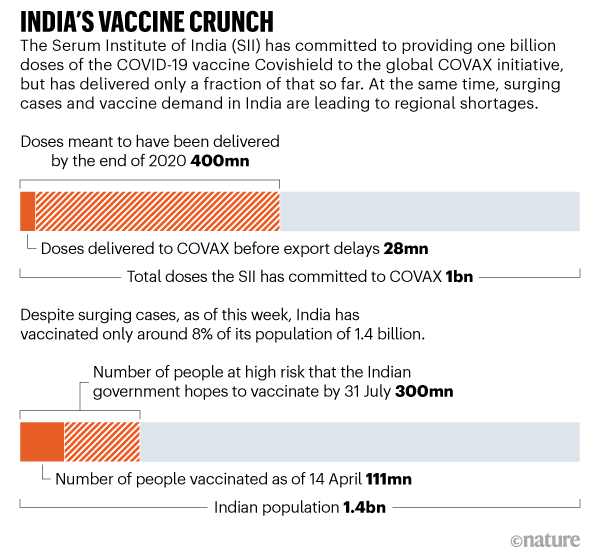Hello Nature readers, would you like to get this Briefing in your inbox free every day? Sign up here

People wait to receive a COVID-19 vaccine at a vaccination centre in Mumbai.Credit: Indranil Mukherjee/AFP via Getty
India’s COVID-vaccine woes
India, one of the world’s biggest vaccine suppliers, is facing a COVID-19 vaccine crunch, partly due to an explosion of cases linked to new variants. This spells trouble for many countries relying on Indian-made vaccines supplied through the World Health Organization’s COVAX initiative for equitable access to vaccines. On Monday, India reported almost 170,000 new COVID-19 cases, its highest daily total yet. It has now had more than 13.5 million confirmed cases, overtaking Brazil as the world’s second-worst-hit country, behind the United States. India is meant to supply one billion vaccine doses to COVAX, but only 28 million have arrived so far.

Mega-dish telescope goes international
Astronomers living outside China can now submit proposals to use the Five-Hundred-Meter Aperture Spherical Radio Telescope (FAST), the world’s largest single-dish telescope. Ten per cent of the telescope’s time will be open to foreign scientists. The move is particularly welcomed by scientists who were relying on the Arecibo Observatory in Puerto Rico, which collapsed last December. “We expect that FAST would not only take the place of Arecibo in supporting astronomers doing good science in relevant research areas, but also make breakthroughs and open new windows for research in radio astronomy,” says astronomer Keping Qiu, the leader of the committee evaluating incoming proposals.
Video: The science of coronavirus variants
SARS-CoV-2 variants are complicated: each one is made up of a collection of mutations, all of which have the potential to change the virus in unexpected ways. A Nature video explores what they might mean for the future of the pandemic.
Nature | 6 min video (on YouTube)
Features & opinion
Plan for domino effects on SDGs
Cascades of extreme events caused by climate change could derail the United Nations Sustainable Development Goals (SDGs), argue researchers Markus Reichstein, Felix Riede and Dorothea Frank. “A heatwave can spark forest fires, which lead to air pollution, thus damaging public health. Drought-wrecked harvests can result in food-price volatility, which can increase social unrest or migration,” they write. “Yet these domino effects are barely considered in most countries’ strategies for achieving the [SDGs].” The authors outline how new models, better metrics and more investment can better prepare us for the changing and interconnected nature of risk in a warming world.
It’s really hard to tidy up in space
Halting efforts to remove space junk illustrate how hard it is to clean up Earth orbit. Proof-of-concept missions, such as the End-of-Life Services by Astroscale Demonstration (ELSA-d), which launched last month, offer some hope. But the continuing launch of ‘megaconstellations’ of tens of thousands of satellites, such as SpaceX’s Starlink system, far outpace any clean-up efforts. Space scientists increasingly fear a runaway cascade of collisions that would make low-Earth orbit unusable — a scenario dubbed ‘the Kessler syndrome’ after NASA orbital-debris researcher Donald Kessler. But there is little monetary reward for clearing up after yourself in space. And there’s the additional worry that any technology that could remove junk could also be used as a weapon against satellites.
Scientific American | 7 min read
Beyond the breathalyser
Breathalysers have been used to look at blood alcohol content since the 1950s, but there is a lot more to discover in our breath. More accurate tests for drink and drugs could make roadside testing easier or allow people to test themselves before they get behind the wheel. And biomarkers in the air we breathe could identify lung inflammation and even SARS-CoV-2, ushering in a new age for breath tests.
Image of the week

Chemist Richard Layfield was shocked when a retiring colleague at the University of Sussex passed him the original samples of fullerenes — C60 and C70 — purified by the late Harry Kroto. Kroto was at Sussex when he shared the 1996 Nobel Prize in Chemistry for the discovery of these closed carbon ‘buckyball’ molecules. Layfield was also gifted with the original instrument that analysed them, which still works.(Credit: Richard Layfield)
